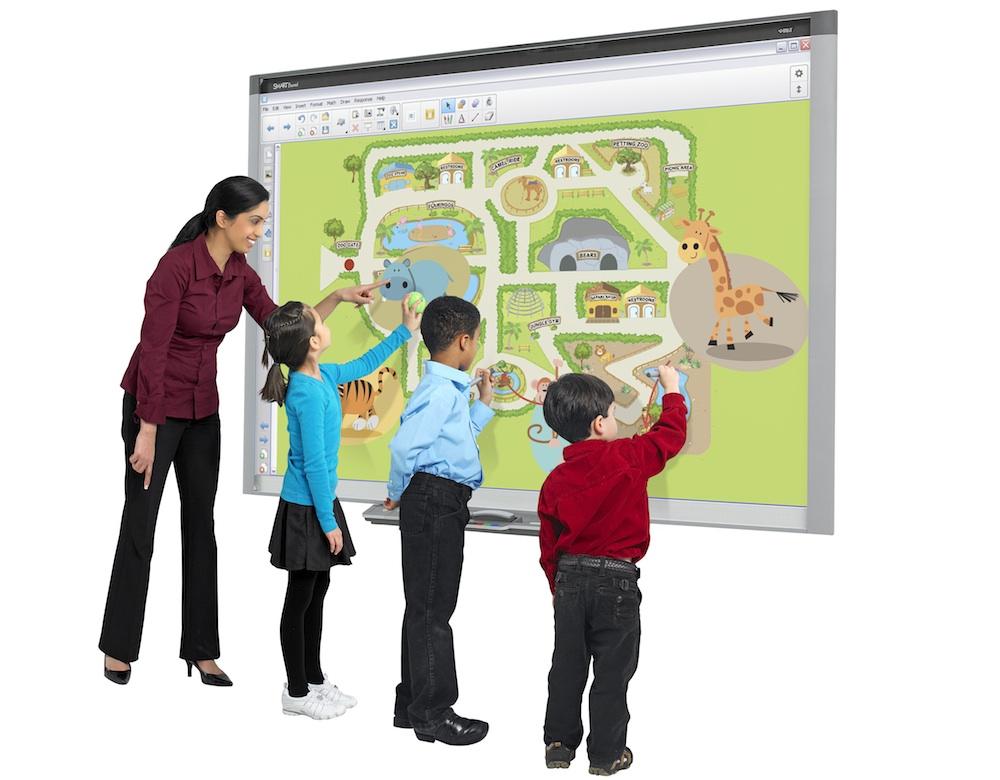
You Finally Have a Smart Board. Now What?? (Technology)
You knew this day might eventually come. SMART Boards have infiltrated classrooms across the province. They used to be as rare as the reclusive puma. But now they are as common as the raccoon. And frankly, you might be happier to see a wild racoon in your classroom. After all, you could gently shoo it out the front door. Or send a page for the bravest custodian. At least no one would expect you to facilitate student learning with it!
For better or for worse, the SMART Board sits in your room with its face gaping blankly at you. The charcoal-grey ledge cradles four plastic marker-shapes and a clearly artificial chalk-brush. You thought you’d be happier. Why is it that the thought that keeps running through your mind is Okay, what now?
As you may already know, SMART Boards are a type of interactive white board (IWB). If the breathless exultations of your colleagues are to be believed, IWBs are the greatest classroom advancement since the automatic pencil sharpener.
SMART Boards are a combination of hardware and software. The hardware is the easy part. Think of it as a large, rectangular mouse. With a touch, you can draw, cruise the Internet, and anything else you would normally use a keyboard and a mouse to do.
What about the software? The software, named SMART Notebook, does what other computer programs do (word processor, handwriting recognizer, paint program) and some tasks that are harder to come by (video integration, Internet links, Flash programs). In fact, the enormous number of widgets, tools, and whatnots that come with the program mean that the potential for classroom tasks is limitless.
SMART Technologies Inc. has also created a lesson exchange site called SMART Exchange. You can find it at exchange.smarttech.com. Teachers from across the province (country, world!) have created their own lessons and uploaded them. Using the ready-made templates, you can create lessons, design inventive assessments, or simply interact with the Internet in fresh ways. While writing this article, I logged on to the Exchange and found fabulous lessons on human muscular systems, electricity, reading graphs, and anagrams.
Let’s say that you need an interactive way to take attendance in your primary classroom. Searching the word attendance at the Exchange generates dozens of free resources. There’s one where the students get to pop their name balloon. Another has them click their name-arrow and watch it fly into the St. Valentine’s Day heart. Or perhaps on a hot September day you’d like your students to click their name-popsicle and watch it melt off the stick! All free and ready for your use!
Speaking of digital resources, the SMART Board makes a fabulous portal to online educational games. There are many websites that offer learning games that you play in the browser. One of my favourite sites, iknowthat.com, provides games organized by topic and grade level.
Okay, so let’s say that you’ve been to the SMART Exchange website and tried a few things out. But now you’re feeling brave and ready to make SMART technology your own. There are three things you need to remember when jumping into the pool of SMART lesson planning.
1. Digitize What You’ve Already Been Doing
The work you’ve been doing in class is an excellent place to start because you know it so well. For example, your lesson on editing paragraphs can be typed as text on the SMART Board and edited by students using interactive markers. And when was the last time you used a metre stick to draw out graph paper on the chalk board? Be honest: did you work through a recess to make sure the lines were clean and parallel? The SMART Notebook program’s graph paper background has just saved you 20 minutes. Couple that with the line-segment function, and you have a perfectly crisp line graph without having to skip your coffee break. Suddenly, your oldschool lessons are nitro-boosted into the twenty-first century.
2. Use the gallery items
As I mentioned earlier, the SMART Board software, Notebook, comes pre-installed with a toolkit of handy-dandy digital widgets. You need dice? Or a spinner? Perhaps a timer for a game? No sweat. Those items are already included. Maybe you want to clang around on a digital keyboard. No problem, it’s there too. Oh, and this is my favourite, what if you have an overpowering desire to dissect a frog, but don’t like the smell of formaldehyde? There’s even a froggy, its fleshy belly exposed for your digital scalpel and pixelated flesh pins, ready at a moment’s notice. Happy biology lesson!
3. Develop the Smart Board as a centre before incorporating the entire class
Do you use centres for literacy or numeracy? If so, a SMART Board activity will provide an exciting centre for a small group of students. Depending on the lesson, you will be able to leave it in their capable hands. Perhaps it is a math problem that they have to solve. An online game to complete. Questions to investigate. Whatever it is, your students will be so delighted by the novelty of the device that they will focus on the lesson with the intensity of terriers on a squirrel.
In conclusion, let me tell you that I know what you’re thinking. You’re probably wanting to say, “Listen Jeff, moving lessons to the SMART Board is not a revolution. Nothing is improved by simply changing the format.” And while I would normally agree with you, let me assure you that students will be more engaged. Sure, it seems an oversimplification to say that simply digitizing paperwork will increase student engagement, but I challenge you to prove me wrong. I believe that you will be astonished by how on-task attention increases and off-task behaviour decreases by simply involving the SMART Board. It’s weird, I agree. Who knew that pixels would be such good motivators?!
If nothing else, I hope that wild racoon is looking a little friendlier now. What looked like a furry woodland menace a little while ago is now a willing and able ally. You know what? This might work out after all.
Looking for more ideas? Try these on for size
Primary division
- Use the cloning function to create a bar graph of the weather. Track it for a month and then convert the image into a saveable .pdf file.
- Convert YouTube songs into Flash video files and embed them into the morning song time. Now you can all do the actions together with your favourite character!
Junior division
- To review a unit, students can design quiz questions for their classmates using “pen-eraser hide” or “magic box” techniques. Simple SMART Board “tricks” like those can make a review quiz interactive and fun to play.
- Host your own Current Events news show. If you paste an image in the top left corner and project it on a student “news anchor,” you can produce a television news broadcast complete with an authentic icon box.
Intermediate division
- Develop a student-created biome project with integrated video Google Earth tours. Now you can all “visit” the ecosystem!
- Use Google Maps and “infinite cloner” to create a map that includes demographic information. Using symbols, you can create a visual display of population density and main industries.
